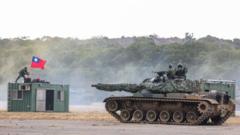The recent relocation of 105 Marines to Guam represents the beginning of a long-awaited agreement, aimed at reducing the American military footprint on the island, albeit amidst delayed schedules and ongoing geopolitical tensions.
U.S. Marine Relocation from Okinawa: A Decades-Long Transition

U.S. Marine Relocation from Okinawa: A Decades-Long Transition
In a significant but gradual shift, the U.S. Marines are starting to relocate from their base in Okinawa, Japan, raising concerns about regional security in the face of China's rising influence.
Before Christmas, a small contingent of 105 U.S. Marines stationed in Okinawa were reassigned to a base in Guam. This change is notable as it marks the first decrease of Marine personnel on the island since a military agreement aimed at reducing the U.S. military presence was established over two decades ago. Under this agreement, a total of 9,000 Marines—approximately half of the current force in Okinawa—are set to leave the island; however, their deployment is already two decades behind schedule, with completion still likely over a decade away as construction of new facilities progresses slowly.
The plan to reduce U.S. military presence in Okinawa traces back to a series of negotiations prompted by anti-American sentiment on the island, notably after an incident in 1995 in which three U.S. servicemen were implicated in the rape of an Okinawan schoolgirl. This led to large-scale protests and a re-evaluation of the U.S. military’s role in Japan, resulting in the 12-year-old agreement that remains partially unfulfilled today.
Despite initiating the relocation of some Marines, the broader geopolitical picture complicates these changes. The U.S. maintains a significant military presence in the region, particularly in response to perceived threats from China. The construction of new bases is crucial not only for the relocation agreement but also for ensuring that U.S. forces are strategically positioned to deter any regional aggression.
As Okinawa continues to be home to major U.S. military bases, discussions around military presence highlight tensions between local communities, U.S. military interests, and regional security dynamics. While some Okinawans advocate for a reduction in the military footprint, concerns remain regarding the implications for both local and international security as China’s military assertiveness grows. The first stages of this military transition are, therefore, not viewed in isolation but are seen as part of a larger narrative in ongoing U.S.-China relations.
The path forward is fraught with complexities, including the slow pace of base construction and the geopolitical backdrop, which could either accelerate or delay the military's planned withdrawal from Okinawa. The U.S. military's future in Okinawa still rests on delicate partnerships, public sentiment, and the broader context of an increasingly competitive Indo-Pacific landscape.
The plan to reduce U.S. military presence in Okinawa traces back to a series of negotiations prompted by anti-American sentiment on the island, notably after an incident in 1995 in which three U.S. servicemen were implicated in the rape of an Okinawan schoolgirl. This led to large-scale protests and a re-evaluation of the U.S. military’s role in Japan, resulting in the 12-year-old agreement that remains partially unfulfilled today.
Despite initiating the relocation of some Marines, the broader geopolitical picture complicates these changes. The U.S. maintains a significant military presence in the region, particularly in response to perceived threats from China. The construction of new bases is crucial not only for the relocation agreement but also for ensuring that U.S. forces are strategically positioned to deter any regional aggression.
As Okinawa continues to be home to major U.S. military bases, discussions around military presence highlight tensions between local communities, U.S. military interests, and regional security dynamics. While some Okinawans advocate for a reduction in the military footprint, concerns remain regarding the implications for both local and international security as China’s military assertiveness grows. The first stages of this military transition are, therefore, not viewed in isolation but are seen as part of a larger narrative in ongoing U.S.-China relations.
The path forward is fraught with complexities, including the slow pace of base construction and the geopolitical backdrop, which could either accelerate or delay the military's planned withdrawal from Okinawa. The U.S. military's future in Okinawa still rests on delicate partnerships, public sentiment, and the broader context of an increasingly competitive Indo-Pacific landscape.





















